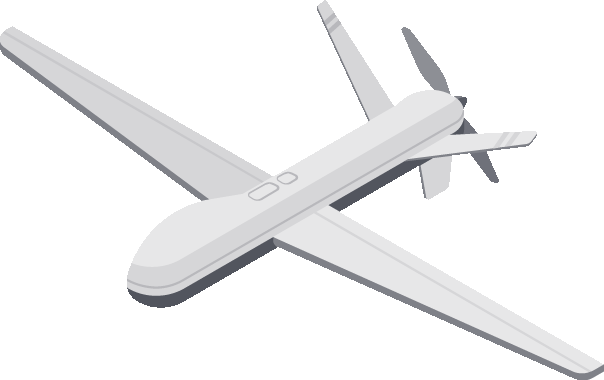From aerial surveying to precision agriculture and infrastructure inspection, the power and potential of fixed-wing drones come with significant safety responsibilities. Operating a fixed-wing drone demands a meticulous approach, adhering to stringent safety protocols to mitigate risks to yourself, others and the surrounding environment.

“There are things you can do, and these will be covered in the instructions of the UAV you choose. But with the technology now maturing, you have a lot of feature and quality options for reasonable prices (especially considering the money you make and save investing in a good system). So choosing the right system is the most important thing to do, first,” remarks Wingtra Senior Content Manager, Emily Loosli.
“Fundamentally,” she continues, “if the fixed-wing drone platform does not feature vertical take-off and landing (VTOL) I would not recommend investing in it. The reason is that VTOL allows you to take off and land in a more controlled way and in a smaller area, whereas traditional fixed wings require large areas and often crash land and are challenging to launch safely. Unless you really need a particular fixed-wing without VTOL, go with VTOL.”
Additionally, investing in a fixed-wing drone is a significant decision, particularly for professional applications. Thoroughly evaluating the safety features, both automated and manual, to ensure a safe, efficient and productive operation.
According to Loosli, “Automation is very important as well: does the system have an automated and intuitive pre-flight safety checklist? Does the system provide intuitive geobarrier setup for larger areas? How is the VTOL range on the fixed-wing craft? The more user-friendly and thorough the safety features on the fixed-wing VTOL drone, the more control you have over the features that are not automated.” She emphasizes, “There should be a degree of manual control when unexpected things happen, as well. Check for in-app controls and manual options. Ask all of these questions and get a demo to check these things when investing.”
So, what are the best practices for ensuring safe and responsible operation.
Pre-Flight Checklist: The Foundation of Safe Operation
Before even considering powering up your fixed-wing drone, a comprehensive pre-flight checklist is important. This checklist should become second nature, ingrained in your operational routine. Elements to include are:
–Weather Conditions: Fixed-wing drones are more susceptible to wind. Check the forecast meticulously. High winds, turbulence, rain, snow, or fog can all render operation unsafe and potentially lead to a crash. Pay close attention to wind speed and direction, considering gusts and potential changes during your flight. A calm, clear day is ideal.
However, as Loosli recommends, “Once you are looking at VTOL fixed-wing options, check carefully that the craft is stable in wind. There are a few leading models out there and they perform differently. Talk to people about their performance in wind and if they truly can handle the high end of their wind range without drifting out of the landing and take-off area. Get a demo to show this.”
–Battery Health: Ensure your drone’s battery is fully charged and in good working condition. Use only manufacturer-approved batteries and regularly inspect them for any signs of damage or swelling. Battery failure mid-flight is a major safety hazard.
–Drone Inspection: Conduct a thorough visual inspection of your fixed-wing drone. Check for any damage to the airframe, propellers, motors, or other components. Loose screws, cracks, or bent parts should be addressed before flight. Verify the correct installation of all components, including the flight controller, GPS module, and radio receiver.
–Flight Area Assessment: Before launching, meticulously survey your intended flight area. Identify any potential hazards, including tall buildings, trees, power lines, bodies of water and obstacles that could interfere with the drone’s flight path. Be aware of airspace restrictions and regulations in your area. Consider the presence of people, animals and vehicles. Establish clear visual observation points and plan for contingencies.
–Radio Control Range: Confirm that you have a clear and uninterrupted line of sight with your drone throughout the planned flight. Understand the limitations of your radio control system’s range and avoid flying beyond this distance. Consider factors like radio frequency interference (RFI) from other electronic devices.
–Emergency Procedures: Familiarize yourself with emergency procedures, including how to regain control of your drone in case of unexpected malfunctions, how to perform an emergency landing, and the steps to take if communication is lost. Practice these procedures in a safe, controlled environment before undertaking any high-risk flights.
–During Flight: Maintaining Situational Awareness
Maintaining continuous situational awareness is critical during the entire flight. This means constantly monitoring your drone’s position, altitude, speed, and battery level. Key practices include:
Line of Sight: Never lose visual contact with your fixed-wing drone. If visibility is impaired, land immediately and safely.
Obstacle Avoidance: Remain vigilant for any unexpected obstacles that may appear during flight. Utilize your drone’s obstacle avoidance system (if equipped) and rely on your own judgment.
Communication: If flying with a team, maintain constant communication. This is particularly crucial for complex operations.
Battery Monitoring: Plan for sufficient reserve power to ensure a safe return. Never allow the battery to completely deplete in flight.
Weather Monitoring: Continue to monitor the weather conditions for any sudden changes. Be prepared to land immediately if conditions become unfavorable.
Post-Flight Procedures: Completing the Cycle Safely
Post-flight procedures are as crucial as pre-flight checks. They ensure the safe storage of your equipment and contribute to the overall safety record.
Drone Inspection: After landing, conduct another visual inspection of your drone for any damage incurred during the flight.
Data Review: Review the flight logs and data recorded by your drone to assess the performance and identify any potential issues.
Battery Care: Properly store and charge your batteries according to manufacturer recommendations.
Cleaning & Maintenance: Clean your drone and perform routine maintenance to ensure its continued safe operation.
Regulatory Compliance and Ethical Considerations
Beyond these operational best practices, you must also adhere to all relevant local, national, and international regulations concerning drone operation. This includes obtaining the necessary permits and licenses, registering your drone, and respecting airspace restrictions. Flying responsibly and ethically is paramount. This extends to respecting the privacy of others, avoiding populated areas unless absolutely necessary, and adhering to any specific restrictions related to your drone’s operation in certain environments.
Operate Safely
Prioritizing safety not only minimizes risks but also enhances your credibility as a drone operator. Loosli advise to drone pilots, “Once you have a system you can trust, follow all the safety instructions when operating the UAV and abide by regulations. Commercial fixed-wing UAVs are serious pieces of equipment, so I recommend not testing the limits but instead really staying within them.”



